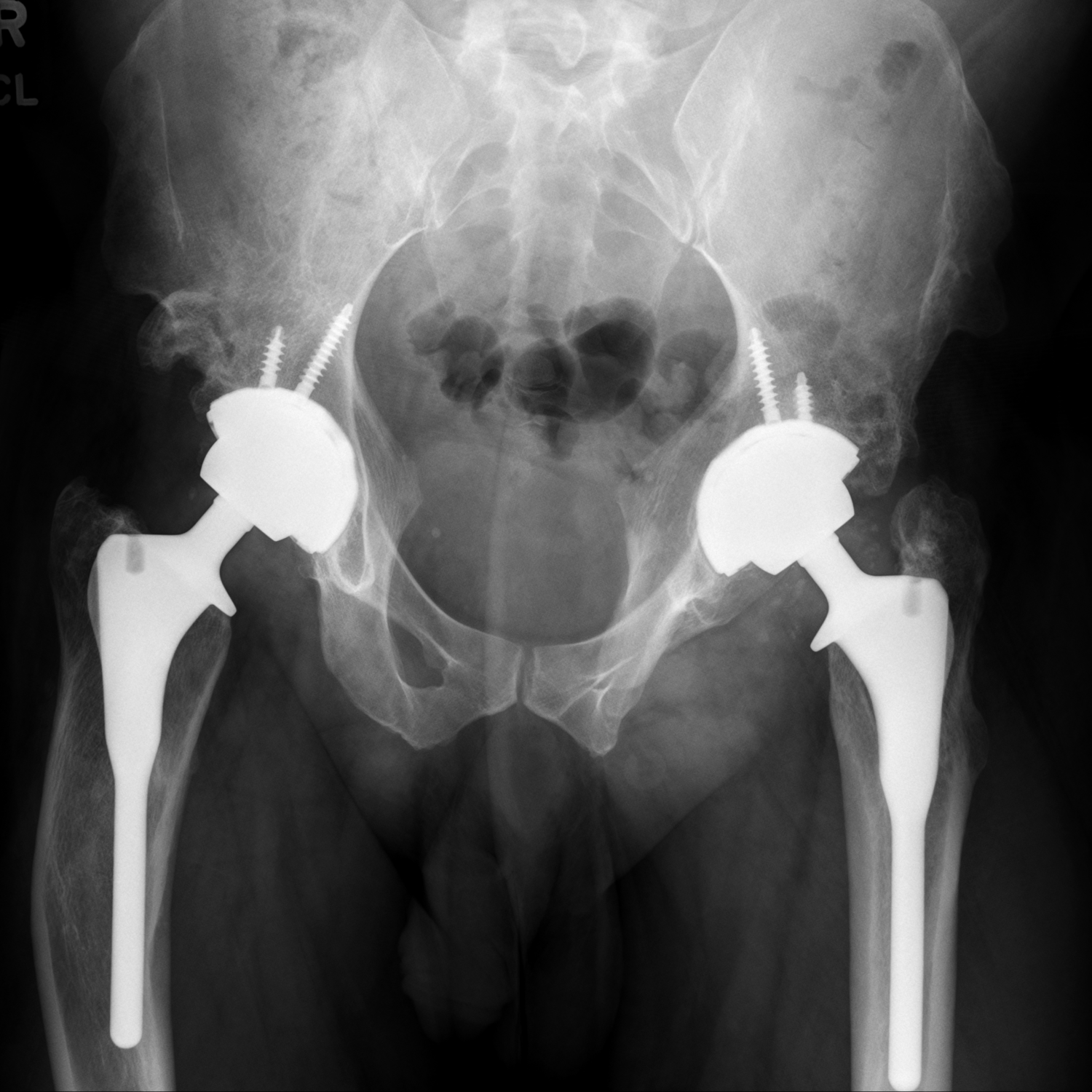CASE 7: Revision of a painful hip implant due to synovitis from wear of the polyethylene bearing
The Story
“Umar attended my clinic aged 39 with a one-year history of a very painful left hip replacement. He had a background of bilateral developmental dysplasia of the hip, which was treated with multiple operations to try and form a bony acetabulum.
"By the age of 26 he had required bilateral total hip replacements. On the left he had a ceramic-on-ceramic THR with a Furlong stem and a threaded acetabular cup. On the right he had a metal-on-polyethylene THR with the same components. These operations had been very successful for Umar up until this point.”
The Investigation
On clinical examination, Umar had a positive Trendelenburg test on the left hand side. He was able to mobilise with the aid of a stick. Raising his legs straight up off of the couch was possible but uncomfortable on both sides. His range of movement was restricted on both sides and rotation of the left hip was particularly irritable.
His Oxford Hip Score was 14/48 on the left.
His blood CRP was <10mg/L helping to rule out infection.
A left hip aspiration and extended microbiological culture further helped to rule out an infection.
A bupivocaine local anaesthetic hip injection (into the left hip at the time of aspiration) helped to relieve his pain for 24-hours (a useful test when evaluating unexplained, painful hip replacements).
The Evidence
Anteroposterior plain radiograph demonstrates well fixed and well positioned bilateral Furlong hip replacements with threaded cups. The left has a ceramic head and the right has a metallic head. There radiolucent area surrounding the left cup is artefact with no evidence of osteolysis.
Lateral plain radiograph of the left hip showing a slightly retroverted cup.
Coronal MRI demonstrating a large amount of scar tissue around the musculature of the left hip.
We also performed a CT SPCET scan to assess for loosening of the components. This showed no evidence of loosening or infection and no evidence of lumbar spine or pelvic pathology.
The Diagnosis
Umar was diagnosed with a painful left ceramic-on-plastic Furlong hip replacement secondary to polyethylene induced synovitis.
The Plan
We knew we would have to operate on both hips. However, as the left was causing Umar more issues at this time, we decided to revise the left hip joint first, followed by the right after a period of recovery. We aimed to use a highly porous hemispherical cup while retaining the well fixed stems.
The Operation
Umar’s left hip was revised first. Intraoperatively, the acetabular ceramic liner was found to be de-laminating and breaking up. Additionally, there was synovitis so a synovectomy was performed and 5 tissue samples sent for extended microbiological culture.
The threaded acetabular cup was explanted with minimal bone loss and replaced with a highly porous (Gription) pinnacle cup. The stem was retained and the head revised to a JRI Furlong ceramic head with titanium sleeve.
We revised the right hip about 9-months later using a very similar procedure.
The Outcome
Anteroposterior plain radiograph demonstrating bilateral highly porous hemispherical (Gription) pinnacle acetabular cups with ceramic-on-ceramic bearings. The two Furlong stems are both well fixed and well positioned.
Umar was very happy with the outcome of his bilateral hip replacements. After a period of rehabilitation, the pain in both hips had completely subsided and he was back to undertaking his normal daily routine.
The Verdict
“Learning points were:
Unexplained painful hip replacements need to be fully investigated before revision is considered, with: blood inflammatory markers; hip aspiration for microbiological extended culture and injection of anaesthetic to confirm or refute the hip as the location for the pain; MARS MRI for soft tissue reactions and muscle damage; and CT Spect for loosening, infection and pain generators in the lumbar spine and pelvis. Additionally, consider blood cobalt and chromium levels when there are cobalt-chromium components (this may pick up taper corrosion).
Revision of ceramic-on-ceramic bearings should ideally use the same bearing type.
Obtain optimum equipment for removal of acetabular components to minimize bone loss.”
-
The first paper to draw widespread attention to the clinical effects of worn polyethylene debris was written several decades ago:
Since that paper, orthopaedic engineers have produced better polyethylenes, through cross-linking and the addition of anti-oxidants to prevent breakage of polymer cross-links. This had the effect of reducing the dose exposed to patients to a level that became clinically insignificant and obviated the need for further research into the cellular mechanisms for polyethylene-induced effects by the biological scientists: the engineers won.
-
-
Please see this case involving the removal of well fixed cups and the equipment used to conserve as much bone as possible:
Acetabular Reconstruction - New Technology - CT Planning 3D Printing - Case Nine






